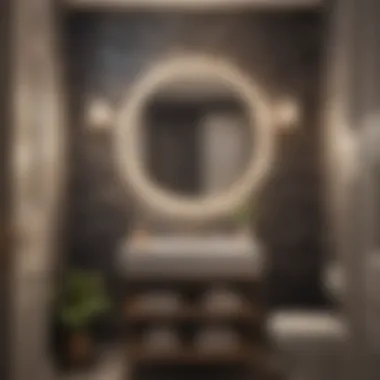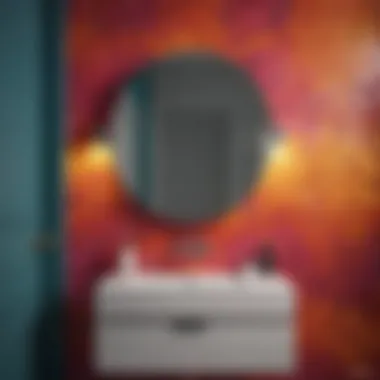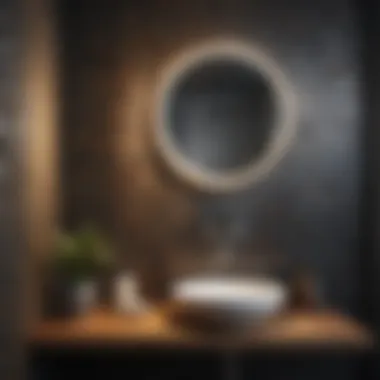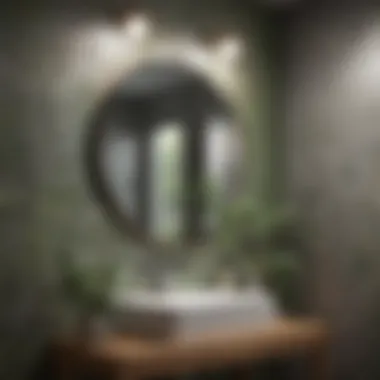Selecting Wallpaper for Small Bathrooms: An In-Depth Guide


Intro
Selecting wallpaper for small bathrooms requires a thoughtful approach that balances aesthetics with functionality. In compact spaces, wallpaper serves not only as a decorative element but also as a practical solution to enhance the overall appearance and feel of the room. This guide aims to equip homeowners and design enthusiasts with essential knowledge about the intricacies of wallpaper selection for small bathrooms. Factors like material, color, and pattern scale will be explored to ensure a harmonious visual experience.
Design Inspirations
Trending Styles
When it comes to choosing wallpaper for compact bathrooms, the style you select can dramatically influence the spatial perception of the area. Minimalist designs are widely appreciated for their understated elegance. Light shades with simple patterns can create an illusion of spaciousness. Alternatively, bold geometric prints can add a sense of personality while providing a contemporary touch. Floral motifs and nature-inspired designs also present an excellent choice, as they tend to evoke tranquility and freshness, ideal for the bathroom setting.
Color Palettes
Color choice is paramount in creating the desired atmosphere. Lighter colors such as soft whites, pastels, or pale blues tend to reflect more light, making a small space feel larger. Darker shades, while sometimes intimidating, can be effective when paired with strategic lighting. For a cohesive look, consider using a monochromatic palette or colors that harmonize well with existing fixtures and décor. Utilizing contrasting colors smartly can create focal points without overwhelming the senses.
Maintenance and Upkeep
Seasonal Maintenance Checklist
To keep wallpaper in optimal condition, a seasonal maintenance checklist can be highly beneficial. This includes:
- Inspecting seams for peeling or lifting.
- Checking for signs of moisture damage, particularly in humid environments.
- Wiping down surfaces to remove dust and grime.
Maintaining vigilance can prolong the life of your wallpaper while keeping the bathroom looking fresh.
Cleaning and Organization Tips
Cleaning wallpaper in a small bathroom might seem daunting, but it is manageable with the right techniques. Use a soft cloth and a mild cleaning solution to gently wipe down the wallpaper. Avoid abrasive materials that can damage the surface. Additionally, keeping the area organized can enhance your ability to maintain cleanliness. Incorporate shelves or cabinets to store essential items, keeping countertops clear and facilitating easier cleaning.
"A carefully chosen wallpaper can transform not only the look but also the mood of a small bathroom."
By taking time to understand the various elements involved in selecting wallpaper, homeowners can effectively enhance their small bathrooms. From trends and colors to proper maintenance, this guide offers a comprehensive road map to achieving a stylish and functional space.
Understanding Wallpaper in Bathroom Design
Choosing wallpaper for a small bathroom involves more than merely selecting a pleasing design. It's about understanding the role wallpaper plays in bathroom aesthetics and its practical implications. Wallpaper can drastically transform a small area, contributing to a comfortable and cohesive environment. It can solve many design issues bathroom owners face, from moisture to limited space.
The Functionality of Wallpaper in Bathrooms
Wallpaper serves a significant purpose beyond decoration. In bathrooms, it can act as a moisture barrier when the right materials are used, protecting the underlying wall surfaces. Properly selected wallpaper can withstand the humidity present in these spaces while also providing insulation against temperature fluctuations. This is especially important in small bathrooms, where effective insulation aids in maintaining comfort.
The choice of wallpaper can enhance the bathroom’s sanitation as well. Many modern wallpapers are washable, which is an essential feature for cleaning frequently exposed surfaces. Moreover, certain types such as vinyl can repel water, thereby extending their lifespan and ensuring a fresh appeal for longer periods. This functionality combined with aesthetic value makes wallpaper a strategic choice for any bathroom renovation.
Advantages of Using Wallpaper in Small Spaces
Utilizing wallpaper in small bathrooms offers various advantages that can significantly impact the overall atmosphere and functionality of the space. Firstly, wallpaper can create an illusion of space; lighter colors can open up tight areas while patterned wallpapers might camouflage how modest the dimensions are.
- Benefits include:
- Versatile Designs: Wallpaper comes in countless styles and patterns, allowing homeowners to express their unique taste and personality.
- Ease of Installation: Many wallpaper types are relatively easy to install and remove, fun for a DIY project.
- Acoustic Insulation: Wallpaper can dampen sound in small spaces, an often-overlooked feature that adds to privacy and tranquility in the bathroom.


Additionally, the presence of wallpaper can substantially elevate the design by adding depth and interest. A well-chosen wallpaper acts as a focal point that can draw attention away from typical bathroom fixtures. Overall, these advantages highlight the practicality and artistic value of wallpaper in small bathrooms.
Types of Wallpaper Suitable for Bathrooms
Choosing the right wallpaper for a bathroom, particularly a small one, is crucial. This section will look into various types that balance style and functionality, ensuring that space is both attractive and practical. Bathrooms are unique environments. They experience higher humidity levels, which can damage ordinary wall coverings. Using the right wallpaper not only protects the walls but also enhances the overall aesthetics.
Vinyl Wallpaper: Durability Meets Style
Vinyl wallpapers are a top choice for bathrooms. Their waterproof nature makes them resistant to moisture and spills. This feature is vital in a room where dampness is a regular issue. Additionally, vinyl comes in a wide variety of styles and colors. Homeowners can find patterns that fit any design theme, whether it's vintage, modern, or whimsical.
Installation is relatively easy because vinyl can be applied directly to most surfaces. It is also effortless to clean. A simple wipe with a damp cloth will remove stains, making it very practical for small spaces that may show wear and tear quickly.
Non-Woven Wallpaper: Breathability for Moisture Control
Non-woven wallpaper is another excellent option for small bathrooms. It allows walls to breathe, preventing moisture buildup. This quality helps reduce mold and mildew, which are common problems in humid areas. The material is made from natural or synthetic fibers, providing strength and durability.
While non-woven wallpaper is slightly more expensive than vinyl, its breathability makes it worth the investment for long-term maintenance. This type of wallpaper is also easy to remove, making renovations less of a hassle. Personal expression can be achieved through its vast range of patterns and colors making it suitable for various decors.
Washable Wallpaper: Practical Option for Small Bathrooms
Washable wallpaper is a convenient choice for small bathrooms. This option can withstand scrubbing, making it suitable for areas prone to moisture and dirt. Families with children or frequent guests will find this particularly beneficial, as it maintains a fresh appearance longer.
Available in multiple styles, washable wallpaper offers flexibility in design. Homeowners can select vibrant patterns to elevate the space or soothing colors for a calming effect. Ease of cleaning means that costly replacements or repairs are less likely.
In summary, the right type of wallpaper can significantly affect the overall look and functionality of a small bathroom. Vinyl, non-woven, and washable options each offer unique benefits. Considering the materials and their respective advantages will help in making an informed choice.
Choosing the Right Pattern and Color
Choosing the right pattern and color for wallpaper in small bathrooms is crucial for many reasons. Wallpaper can significantly influence the visual appeal and feel of a space. When executed correctly, the right combination of color and pattern can enhance the aura of a bathroom, making it appear larger and more inviting. This aspect ties deeply to both aesthetic considerations and psychological effects on occupants. Careful consideration of these elements ensures that you create a harmonious environment that feels both practical and stylish.
Impact of Color on Perceived Space
Color plays a pivotal role in shaping how we perceive the size of a room. In small bathrooms, lighter colors can reflect more light and create an illusion of spaciousness. Soft hues like pale blues, mint greens, or warm whites tend to open up small areas, making them feel airy.
- Light Colors: Ideal for undersized spaces.
- Dark Colors: These can make rooms feel cozy, but may also confine the space visually if overused.
- Adjusting Shades: Subtle variations, such as pastels, can give dimension without overwhelming.
The psychological aspect of color cannot be overlooked. Warmer tones can instill a sense of warmth and comfort, while cooler tones may induce calm, further enhancing the bathing experience. Planning the color scheme is not just about looks; it also connects based on how the space will be used.
Selecting Patterns for Small Dimensions
When it comes to patterns, selecting prints that complement the scale of a small bathroom is vital. Large, bold patterns can be overwhelming and may visually shrink a confined area. Instead, opt for small, repetitive designs or vertical stripes that elongate the space. This choice affects not only the aesthetics but also the ambience.
- Geometric Patterns: They can add a contemporary look while not overpowering the space.
- Floral Motifs: Smaller floral designs work well as they provide aesthetic interest without being too distracting.
- Subtle Textures: Adding slight texture through pattern can create depth without aggression.
Ultimately, the key is balance; the selected pattern should enhance the overall vision of the space without stealing the spotlight from other design elements.
Combining Colors for Cohesion
Successfully combining colors involves creating a cohesive look that ties the space together. A well-thought-out color palette can make a significant difference in how the bathroom feels and looks.
- Monochromatic Schemes: Using different shades of a single color can simplify design choices and create a sense of unity.
- Analogous Colors: Pairing colors that are next to each other on the color wheel can create a subtle contrast that adds visual interest.
- Accent Colors: Introduce one or two accent colors to add character; however, use them sparingly to ensure they complement rather than clash.


By thoughtfully selecting colors and patterns, homeowners can achieve an inviting atmosphere. This not only enhances visual harmony but also creates a smoother transition between various bathroom elements, ensuring the wallpaper acts as a cohesive backdrop rather than a distracting element.
"Thoughtful choices in color and pattern can heighten the experience of any small bathroom, making it a retreat rather than just a functional space."
Application Techniques for Wallpaper in Bathrooms
Understanding the application techniques for wallpaper in bathrooms is crucial, especially for smaller spaces. Proper installation not only enhances the aesthetic appeal but also ensures longevity and functionality in a moisture-rich environment. Adhering to specific techniques can significantly reduce the risk of wear and damage that is often accelerated by humidity. Moreover, careful consideration during application can lead to a seamless finish, contributing to the overall design coherence of the bathroom.
Preparation of the Bathroom Surface
Before applying wallpaper, preparing the bathroom surface is essential. This step lays the groundwork for successful installation. Begin by cleaning the walls thoroughly to remove any dirt, grease, or soap residues. Ensure the surface is dry. If there are any imperfections such as holes or cracks, fill them with spackle and sand down once dry.
A smooth surface prevents the wallpaper from adhering improperly and can unveil flaws post-application. If the walls have previously been painted, consider the type of paint. Glossy paint may require a light sanding to help the wallpaper adhere better. Additionally, applying a primer specifically designed for wallpaper can enhance the bonding properties when the wallpaper is applied.
Applying Wallpaper: Step-by-Step Guide
The actual process of applying wallpaper in a bathroom should be approached methodically:
- Measure and Cut the Wallpaper: Start by measuring the height of your walls. Cut the wallpaper strips slightly longer than necessary. This extra length allows for adjustments during application.
- Apply Adhesive (if needed): Determine if your wallpaper requires paste or is pre-pasted. If using traditional wallpaper, apply adhesive evenly on the back using a paint roller or brush. For pre-pasted wallpaper, activate the adhesive according to the manufacturer's instructions.
- Hang the First Strip: Begin at one corner of the wall. Align the top of the wallpaper with the ceiling, then slowly press it against the wall, smoothing from the center outwards to eliminate air bubbles. Use a wallpaper smoother if necessary.
- Repeat for Remaining Strips: Continue applying strips, aligning the pattern as necessary and ensuring that edges are butted together without overlapping.
- Trim Excess: Once all strips are applied, use a craft knife to trim excess wallpaper at the bottom and corners for a clean finish.
This step-by-step guide ensures that your wallpaper is applied correctly, minimizing potential issues down the road.
Dealing with Corners and Edges
Corny areas and edges can pose unique challenges when wallpapering. Here's how to tackle them:
- Inside Corners: When wallpapering inside corners, it is ideal to slightly overlap the two strips of wallpaper. This prevents gaps and helps the wallpaper lay flat.
- Outside Corners: For outside corners, you can either wrap the wallpaper around the corner or cut it to fit neatly at the angle. The choice depends on the thickness of the wallpaper and desired aesthetic.
- Trimmed Lines: Use a straight edge to guide your cuts along the edges, making sure to keep the lines crisp without any ragged edges. Good trimming helps avoid unsightly seams.
- Sealing: After trimming, consider using a seam adhesive or a clear sealant designed for wallpaper to secure edges further and prevent lifting, moisture intrusion, or peeling over time.
Effectively managing corners and edges requires attention to detail and precision, both of which can enhance the overall look and durability of the wallpaper in your bathroom.
Trends in Bathroom Wallpaper Design
Understanding current trends in bathroom wallpaper design is crucial for homeowners and interior design enthusiasts. It offers insights into how wallpaper can elevate the aesthetics of small spaces while balancing functionality and design. Staying updated on trends ensures that your choices resonate with both modern sensibilities and practical needs.
Sustainable Materials in Wallpaper Production
Sustainability has become increasingly important in home design. When selecting wallpaper for bathrooms, opting for sustainable materials can prove to be a smart choice. These materials not only minimize environmental impact but also offer durability and practicality in humid areas.
Sustainable wallpapers can be made from recycled paper, organic fibers, or even natural textiles. For instance, wallpaper made from bamboo is both eco-friendly and provides a distinct texture that enhances visual interest. Choosing products certified by organizations such as the Forest Stewardship Council ensures that the materials are sourced responsibly.
Additionally, these materials often come in designs that reflect natural elements, contributing to a relaxing atmosphere in the bathroom.
Classic vs. Modern Aesthetics
The choice between classic and modern aesthetics in bathroom wallpaper can significantly influence the overall feel of the space. Classic designs, such as damask or floral patterns, evoke a sense of elegance and sophistication. They often incorporate subtle colors that can complement various fixtures and decor elements, making them suitable for traditional bathroom styles.
On the other hand, modern aesthetics tend to favor bold colors and innovative patterns. Geometric designs or abstract motifs can turn a small bathroom into a stunning centerpiece. Homeowners should consider which aesthetic aligns with their overall home design. By merging elements from both styles, one can create a unique blend that speaks to personal taste while ensuring cohesion throughout the property.
Textured Wallpaper: Adding Depth to Small Spaces
In small bathrooms, texture in wallpaper can make a remarkable difference. Textured wallpaper adds visual layers, which helps to create the illusion of a larger space. It can draw attention and act as a focal point, reducing the impact of confined dimensions.


For example, grasscloth or embossed vinyl can provide tactile surfaces that invite touch and often reflect light in intriguing ways. However, it is important to consider application and maintenance. Textured wallpapers may require specific cleaning methods that differ from traditional wallpaper.
Textured wallpaper can elevate a small bathroom into a sophisticated retreat with the right design choices.
In summary, understanding these trending elements can significantly impact your decisions when selecting wallpaper for small bathrooms. By considering sustainability, aesthetic preference, and texture, homeowners can achieve a balance between style and practicality.
Maintenance Tips for Wallpapered Bathrooms
Maintaining wallpaper in small bathrooms is crucial for preserving both its aesthetic appeal and functionality. Bathrooms are subject to high humidity and various contaminants, making it essential to adopt proper upkeep measures. Regular maintenance extends the life of the wallpaper and enhances the overall ambiance of the space. Homeowners should be aware of the specific care required for different types of wallpaper, as well as how to spot potential damage early. This knowledge allows for timely interventions, ensuring that the wallpaper remains a beautiful part of the bathroom interior.
Cleaning Methods for Different Wallpaper Types
Different wallpaper types demand varying cleaning methods. Understanding how to clean wallpaper properly can prevent lasting damage and stains. Below are some common wallpaper types and their respective cleaning techniques:
- Vinyl Wallpaper: This is one of the most popular choices for bathrooms due to its durability and moisture resistance. To clean, use a damp cloth with mild soap. Avoid harsh chemicals to maintain its finish.
- Non-Woven Wallpaper: These wallpapers are known for their breathability and are generally easy to clean. A soft sponge and lukewarm water usually suffice. Be careful not to soak the wallpaper, as excessive moisture can damage the adhesive.
- Washable Wallpaper: Designed for easy cleaning, washable wallpaper can handle more aggressive cleaning methods. A soft scrub brush can be used with a mild cleaning solution. Ensure to rinse thoroughly to avoid residue build-up.
In all cases, it is prudent to test any cleaning method on a small, inconspicuous area first. This allows you to see how the wallpaper reacts without risking damage to the entire surface.
Identifying Signs of Damage and Repair Strategies
Monitoring for damage in wallpaper is important for both aesthetics and structural integrity. Here are some common signs of damage to look for:
- Bubbles and Ripples: These occur when moisture gets beneath the wallpaper. It is crucial to act quickly to fix these issues. Puncturing the bubble gently with a pin can release trapped air, and a glue stick may help reapply the wallpaper back down.
- Peeling Edges: This may happen due to poor adhesion or moisture levels. If the edges are lifting, use a wallpaper adhesive to secure them back in place. A putty knife can assist in smoothing the area afterward.
- Discoloration or Stains: If you notice discoloration, it might be due to mold or mildew, particularly in bathrooms. Cleaning with a mixture of vinegar and water can combat mold growth effectively without damaging the wallpaper. Ensuring proper ventilation can prevent recurrence.
By being vigilant and conducting regular checks, you can maintain the wallpaper effectively. Prompt repair strategies can save you from needing to replace the wallpaper altogether.
Remember: Regular inspections and prompt actions can extend the life of your wallpaper, maintaining a fresh and inviting bathroom atmosphere.
The End: Elevate Small Bathrooms with Thoughtful Wallpaper Choices
In the quest to transform small bathrooms, the selection of wallpaper emerges as a pivotal element. It is not merely about aesthetics; choosing the right wallpaper enhances the space's functionality. The right wallpaper can introduce a sense of cohesion and elegance while also maintaining resilience against the bathroom's unique challenges, such as humidity.
Thoughtful wallpaper choices allow homeowners to express individuality and style without overwhelming their compact spaces. The right design elements can create an illusion of space and depth, subtly changing how the room is perceived. Thus, wallpaper can serve both decorative and practical purposes.
"A small space does not limit creativity; rather, it challenges us to think more deeply about choices."
Selecting wallpaper requires consideration of materials, colors, and patterns. Each factor influences not just how the bathroom looks, but also how it functions. For instance, vinyl wallpaper offers durability, which is key in humid settings, while lighter colors can visually expand tight spaces. Thus, these considerations become crucial in ensuring that the wallpaper not only looks appealing but also endures through wear and moisture.
Ultimately, the conclusion drawn from this exploration is clear: wallpaper is an effective means to elevate small bathrooms, imbuing them with character and style while addressing practical needs.
Encouragement for Personal Expression
Small bathrooms should reflect the personality of their owners. They are spaces where one can explore personal tastes without the confines of larger design considerations. The variety of wallpaper available allows for creativity in choices. Whether opting for bold colors or intricate patterns, it is important to choose designs that resonate personally.
Using wallpaper in small bathrooms means embracing the freedom to make daring choices. Here are a few suggestions to guide this personal expression:
- Reflect on favorite colors or themes that might resonate with your style.
- Consider mixing and matching patterns to create visual interest without overwhelming the senses.
- Think of the mood you wish to establish; playful, calm, or vibrant.
Choosing wallpaper can enhance the room's energy, making it a small oasis within the home, encouraging an environment filled with joy and relaxation.
Final Considerations for Lasting Impact
As the final thoughts consolidate, several key points emphasize the significance of wallpaper in small bathrooms. A well-chosen wallpaper not only adds beauty but can also impact the quality of the environment, improving the overall experience of the space. The thoughtfulness in selection will dictate the longevity of the design and overall satisfaction.
Key considerations include:
- Material Longevity: Selecting durable materials designed for moist environments ensures the wallpaper stands the test of time.
- Maintenance: Understanding how to clean and care for the chosen wallpaper will preserve its look and functionality.
- Trends vs. Timelessness: Striking a balance between current trends and classic designs helps ensure your bathroom remains stylish for years to come.







